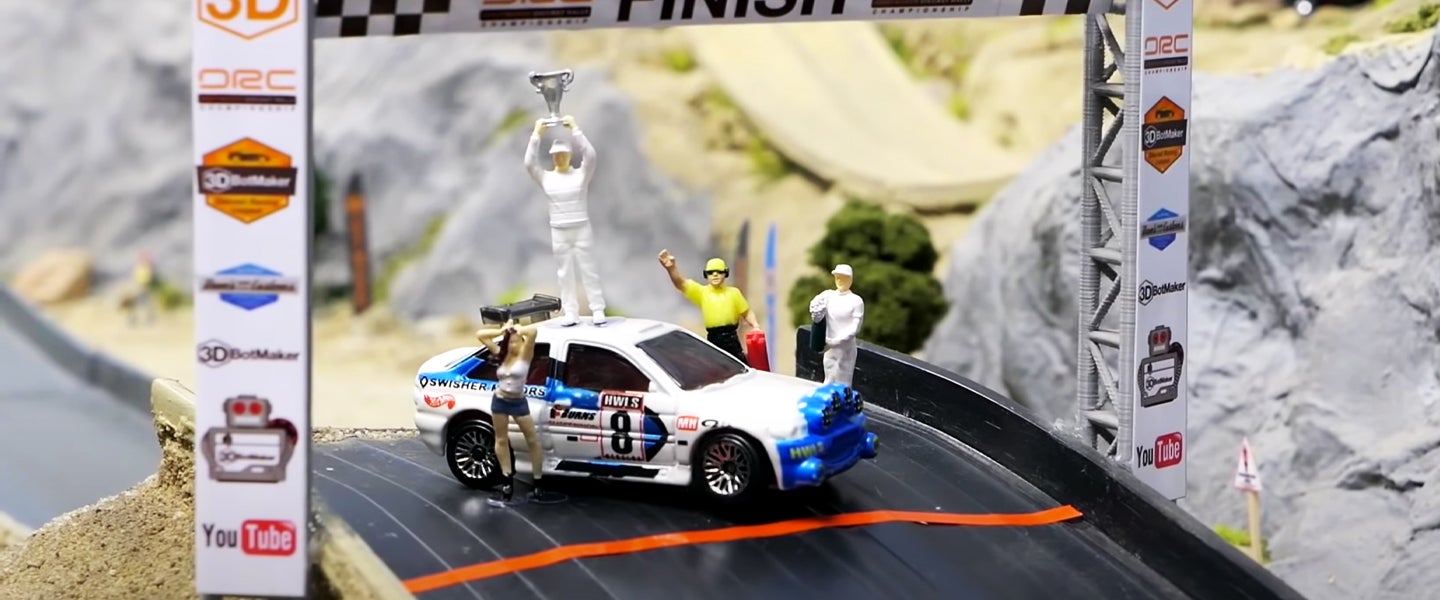When I originally began watching the Diecast Racing Championship (DRC) series on YouTube — downhill rally races for Hot Wheels and Matchbox cars — I immediately thought of my friend Derek, who has purchased thousands and thousands of dollars worth of toy cars over the years. But naturally, just like when we used to play Gran Turismo for hours on end, he was already way ahead of me. He first started checking out the DRC last year, long before quarantine pushed me to find new sports, which is how, wormholing around online, I recently discovered it.
“I love the whole suspension of disbelief, like when the announcers say, ‘There’s a lot of people showing up tonight!’” Derek tells me. “So much of what I appreciate about it is not the cars or the racing, it’s the announcers — they do super good commentary. The video editing is super tight, too. And the camerawork? They’ve got like five cameras, and there’s a robot camera on the track. The edits are fantastic as well. Honestly, it’s all awesome.”
The two announcers, known as 3D and 2D, are great. They describe the scene with all the confidence you’d expect from a Formula One broadcast, even providing contentious histories between rival drivers or between certain cars and the track. As for the races themselves, they’re either of the rally variety (which, given all the crashes, are my favorite) or between any type of cars you can think of — Ferraris, classic muscle cars, 1970s vans, etc. Meanwhile, the tracks are elaborately designed, landscaped and decorated with figurines like tiny traffic cones. They also have their own storied names like Race Canyon and Race Mountain Speedway.
It’s all the brainchild of a man named Adriel Johnson, who runs 3DBotMaker, which operates the racing league. “3DBotMaker started when I bought my son his first Hot Wheels track,” he writes on the 3DBotMaker about page. “It was a simple set (a clamp, a few feet of track and a jump) but it sparked a big passion for diecast racing. Over the years, 3DBotMaker has grown into a product line of track accessories and a diecast racing channel. Our goal is to spread the fun of diecast racing, and remind everyone that you’re never too old to play with your toys. Here’s to the inner child in all of us!”
All of his aforementioned track accessories are 3D printed, hence the name 3DBotMaker, but the race cars are not. They’re the same Hot Wheels and Matchbox cars of yore. “The way it works is, if you send a car in to race, you’re a sponsor,” Derek explains. “Then you make your pick on a race. If you win, you become a driver for the next race and the announcers will be calling out your name. It’s just adorable how seriously and inclusively this guy takes it.”
Because of the quantum nature of reality, a lack of drivers or working engines doesn’t remove the drama from each race. “Some cars are faster than others,” Derek says. “But even if you put the fastest car on the track, at some point it’s gonna bail and flip off the track.” In other words, it’s not just the heavier car that wins, as too heavy of one might roll out of a 180-degree turn.
The cars, vans or whatever featured in the DRC come in two flavors: stock and modified. Stock means they run the same way they came out of the packaging; modified means the wheels and axle may have been swapped out, the chassis of one car may have been mounted with the body of another or weight may have been added.
“Any standard Hot Wheels car is about 25 to 35 grams. Some models are heavier; some have better weight distribution. And there are a bajillion different Hot Wheels wheels, but there’s one series that came out in 2005 or 2006 that they still make today called Faster Than Ever. In the industry, guys just call it FTE,” Derek explains with a good-natured laugh. “You know they’re FTE wheels because they’re always bronze-colored with five spokes.”
“They’re faster because they have nickel-plated axles, have less friction and spin better,” he continues. “So the modified classes, if they don’t already have FTE wheels and axles, racers will swap them from another car, or use that chassis and put a different top on it. And they always add weight.”
Otherwise, the rules and regulations are pretty straightforward:
2 head-to-head runs
Bottom two in points will be eliminated
1 point for crossing each checkpoint and finish line
2 points for first place finish
1 bonus point for Big Air Flying Finish
“Big Air Flying Finish” refers to the jump at the finish line. The trick of the downhill track is that rally cars must maintain enough speed to climb up and over the final hill at the end of the track. If the cars collide coming through a turn or bump racing down a straightaway, they often can’t traverse the hill and thus receive a DNF disqualification. However, if a rally car does make that last jump, staying in the air as it flies across the finish line, with all four wheels off the track — boom! — the driver/car gets a little something extra points-wise.
Derek tells me that DRC and 3DBotMaker have proven so inspirational to him that he’s planning to create his own private diecast race league, bringing a little bit of the action home for himself. “I’ve been clearing out part of my room so that I can make a track set,” he says. “My boys can pick cars, and we can post vids — you know, just between friends.”

